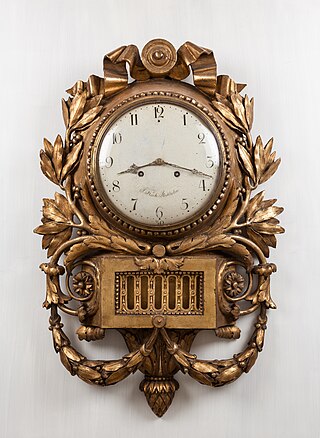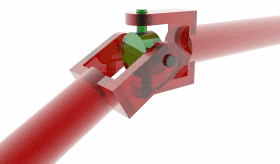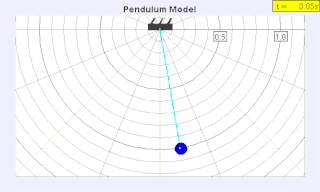Simulation mechanisms
All equation clocks include a mechanism that simulates the equation of time, so a lever moves, or a shaft rotates, in a way that represents the variations of the equation of time as the year progresses. There are two frequently-used types of mechanism:
Cam and lever mechanism
In this type of mechanism, a shaft is driven by the clock so it rotates once a year, at constant speed. The shaft carries a cam, which is approximately "kidney shaped" such that its radius is essentially a graph of the annual variation of the equation of time. A follower and lever rest against the cam, so that as the cam rotates the lever moves in a way that represents the changing equation of time. This lever drives other components in the clock.
Double shaft mechanism
To a close approximation, the equation of time can be represented as the sum of two sine waves, one with a period of one year and the other with a period of six months, with the relative phase varying very slowly (marginally noticeable over the course of a century). See the explanation in Equation of time for more detail.
The double shaft mechanism has two shafts rotating at constant speeds: one turns once a year, and the other twice a year. Cranks or pins attached to the two shafts move the two ends of a combining lever (sometimes referred to as a whippletree) sinusoidally; if the dimensions are chosen correctly, the midpoint of the rod moves in a way that simulates the equation of time.
Types of equation clock
During the period when equation clocks were made and used, all clocks were made by hand. No two are exactly alike. Many equation clocks also have other features, such as displays of the phase of the moon or the times of sunrise and sunset. Leaving aside such additions, there are four different ways in which the clocks function. The following paragraphs are intended, not as detailed descriptions of individual clocks, but as illustrations of the general principles of these four different types of equation clock. The basic workings of particular clocks resemble these, but details vary. Pictures and descriptions of various equation clocks, which still exist in museums, can be accessed through the External links listed below.
Clocks without solar time displays
Many equation clocks, especially early ones, have a normal clock mechanism, showing mean time, and also a display that shows the equation of time. An equation of time simulation mechanism drives the pointer on this display. The user has to add the equation of time to clock time to calculate solar time.
Clocks that directly display solar time
Most later equation clocks, made in the 18th century, directly display solar time. Many of them also display mean time and the equation of time, but the user does not have to perform addition. Three types exist:
Clocks with movable minute markings
Clocks have been constructed in which the minute markings are on a circular plate that can be turned around the same axis as the hands. The axis passes through a hole in the centre of the plate, and the hands are in front of the plate. The minutes part of the time shown by the clock is given by the position of the minute hand relative to the markings on the plate. The hand is driven clockwise at constant speed by the clock mechanism, and the plate is turned by the mechanism that simulates the equation of time, rotating anticlockwise as the equation of time increases, and clockwise when it decreases. If the gear ratios are correct, the clock shows solar time. Mean time can also be shown by a separate, stationary set of minute markings on the dial, outside the edge of the plate. The hour display is not adjusted for the equation of time, so the hour reading is slightly approximate. This has no practical effect, since it is always easy to see which hour is correct. These clocks are mechanically simpler than the other types described below, but they have disadvantages: Solar time is difficult to read without looking closely at the minute markings, and the clock cannot be made to strike the hour in solar time.
Clocks with variable pendula
These clocks include a device at the top of the pendulum that slightly changes its effective length, so the speed of the clock varies. This device is driven by a simulation mechanism which moves to simulate the rate of change of the equation of time, rather than its actual value. For example, during the months of December and January, when the equation of time is decreasing so a sundial runs slower than usual, the mechanism makes the pendulum effectively longer than usual, so the clock runs slower and keeps pace with sundial time. At other times of the year, the pendulum is shortened, so the clock runs faster, again keeping pace with sundial time. This type of mechanism shows only solar (sundial) time. Clocks using it cannot easily be made to show mean time unless a separate clock mechanism, with its own pendulum, is included. There are some equation clocks in which this is done, but it requires the clock case to be very sturdy, to avoid coupling between the pendula. Another disadvantage of variable pendulum clocks is that the equation of time cannot be easily displayed.
Clocks that do mechanical addition
In some later equation clocks, a pendulum swings at a constant frequency, controlling a normal clock mechanism. Often, this mechanism drives a display showing mean (clock) time. However, there are additional components: an equation of time simulation mechanism as described above, and a device that automatically adds the equation of time to clock time, and drives a display that shows solar time. The addition is done by an analogue method, using a differential gear. [1] This type of equation clock mechanism is the most versatile. Both solar and mean times can be easily and clearly displayed, as can the equation of time. Striking the hours in both kinds of time is also easy to arrange. After its invention in 1720, [2] this mechanism became the standard one, and was used for much of the 18th century, until the demand for equation clocks ceased.
Similar modern devices
Equation clocks, as such, are no longer widely used. However, components functionally the same as those in equation clocks are still used in, for example, solar trackers, which move so as to follow the movements of the Sun in the sky. Many of them do not sense the position of the Sun. Instead, they have a mechanism which rotates about a polar axis at a constant speed of 15 degrees per hour, keeping pace with the average speed of the Earth's rotation relative to the Sun. Sometimes, a digital representation of this rotation is generated, rather than physical rotation of a component. The equation of time is then added to this constant rotation, producing a rotation of the tracker that keeps pace with the apparent motion of the Sun. Generally, these machines use modern technology, involving electronics and computers, instead of the mechanical devices that were used in historic equation clocks, but the function is the same.

A clock or chronometer is a device that measures and displays time. The clock is one of the oldest human inventions, meeting the need to measure intervals of time shorter than the natural units such as the day, the lunar month, and the year. Devices operating on several physical processes have been used over the millennia.

A clutch is a mechanical device that allows the output shaft to be disconnected from the rotating input shaft. The clutch's input shaft is typically attached to a motor, while the clutch's output shaft is connected to the mechanism that does the work.

The second is the unit of time in the International System of Units (SI), historically defined as 1⁄86400 of a day – this factor derived from the division of the day first into 24 hours, then to 60 minutes and finally to 60 seconds each.

A cam is a rotating or sliding piece in a mechanical linkage used especially in transforming rotary motion into linear motion. It is often a part of a rotating wheel or shaft that strikes a lever at one or more points on its circular path. The cam can be a simple tooth, as is used to deliver pulses of power to a steam hammer, for example, or an eccentric disc or other shape that produces a smooth reciprocating motion in the follower, which is a lever making contact with the cam. A cam timer is similar, and were widely used for electric machine control before the advent of inexpensive electronics, microcontrollers, integrated circuits, programmable logic controllers and digital control.

A sundial is a horological device that tells the time of day when direct sunlight shines by the apparent position of the Sun in the sky. In the narrowest sense of the word, it consists of a flat plate and a gnomon, which casts a shadow onto the dial. As the Sun appears to move through the sky, the shadow aligns with different hour-lines, which are marked on the dial to indicate the time of day. The style is the time-telling edge of the gnomon, though a single point or nodus may be used. The gnomon casts a broad shadow; the shadow of the style shows the time. The gnomon may be a rod, wire, or elaborately decorated metal casting. The style must be parallel to the axis of the Earth's rotation for the sundial to be accurate throughout the year. The style's angle from horizontal is equal to the sundial's geographical latitude.

In astronomy, an analemma is a diagram showing the position of the Sun in the sky as seen from a fixed location on Earth at the same mean solar time, as that position varies over the course of a year. The diagram will resemble a figure eight. Earth often display an analemma as a two-dimensional figure of equation of time vs. declination of the Sun.

Solar time is a calculation of the passage of time based on the position of the Sun in the sky. The fundamental unit of solar time is the day, based on the synodic rotation period. Traditionally, there are three types of time reckoning based on astronomical observations: apparent solar time and mean solar time, and sidereal time, which is based on the apparent motions of stars other than the Sun.

A universal joint is a joint or coupling connecting rigid shafts whose axes are inclined to each other. It is commonly used in shafts that transmit rotary motion. It consists of a pair of hinges located close together, oriented at 90° to each other, connected by a cross shaft. The universal joint is not a constant-velocity joint.

A differential is a gear train with three drive shafts that has the property that the rotational speed of one shaft is the average of the speeds of the others. A common use of differentials is in motor vehicles, to allow the wheels at each end of a drive axle to rotate at different speeds while cornering. Other uses include clocks and analog computers.

The equation of time describes the discrepancy between two kinds of solar time. The word equation is used in the medieval sense of "reconciliation of a difference". The two times that differ are the apparent solar time, which directly tracks the diurnal motion of the Sun, and mean solar time, which tracks a theoretical mean Sun with uniform motion along the celestial equator. Apparent solar time can be obtained by measurement of the current position of the Sun, as indicated by a sundial. Mean solar time, for the same place, would be the time indicated by a steady clock set so that over the year its differences from apparent solar time would have a mean of zero.

An escapement is a mechanical linkage in mechanical watches and clocks that gives impulses to the timekeeping element and periodically releases the gear train to move forward, advancing the clock's hands. The impulse action transfers energy to the clock's timekeeping element to replace the energy lost to friction during its cycle and keep the timekeeper oscillating. The escapement is driven by force from a coiled spring or a suspended weight, transmitted through the timepiece's gear train. Each swing of the pendulum or balance wheel releases a tooth of the escapement's escape wheel, allowing the clock's gear train to advance or "escape" by a fixed amount. This regular periodic advancement moves the clock's hands forward at a steady rate. At the same time, the tooth gives the timekeeping element a push, before another tooth catches on the escapement's pallet, returning the escapement to its "locked" state. The sudden stopping of the escapement's tooth is what generates the characteristic "ticking" sound heard in operating mechanical clocks and watches.

An electric clock is a clock that is powered by electricity, as opposed to a mechanical clock which is powered by a hanging weight or a mainspring. The term is often applied to the electrically powered mechanical clocks that were used before quartz clocks were introduced in the 1980s. The first experimental electric clocks were constructed around the 1840s, but they were not widely manufactured until mains electric power became available in the 1890s. In the 1930s, the synchronous electric clock replaced mechanical clocks as the most widely used type of clock.

The York Minster astronomical clock is a memorial to the airmen operating from bases in Yorkshire, Durham, and Northumberland who were killed in action during World War II, designed by R. Atkinson, and installed in York Minster in 1955.

A seconds pendulum is a pendulum whose period is precisely two seconds; one second for a swing in one direction and one second for the return swing, a frequency of 0.5 Hz.

A mechanical watch is a watch that uses a clockwork mechanism to measure the passage of time, as opposed to quartz watches which function using the vibration modes of a piezoelectric quartz tuning fork, or radio watches, which are quartz watches synchronized to an atomic clock via radio waves. A mechanical watch is driven by a mainspring which must be wound either periodically by hand or via a self-winding mechanism. Its force is transmitted through a series of gears to power the balance wheel, a weighted wheel which oscillates back and forth at a constant rate. A device called an escapement releases the watch's wheels to move forward a small amount with each swing of the balance wheel, moving the watch's hands forward at a constant rate. The escapement is what makes the 'ticking' sound which is heard in an operating mechanical watch. Mechanical watches evolved in Europe in the 17th century from spring powered clocks, which appeared in the 15th century.

The history of timekeeping devices dates back to when ancient civilizations first observed astronomical bodies as they moved across the sky. Devices and methods for keeping time have gradually improved through a series of new inventions, starting with measuring time by continuous processes, such as the flow of liquid in water clocks, to mechanical clocks, and eventually repetitive, oscillatory processes, such as the swing of pendulums. Oscillating timekeepers are used in all modern timepieces.
In horology, a wheel train is the gear train of a mechanical watch or clock. Although the term is used for other types of gear trains, the long history of mechanical timepieces has created a traditional terminology for their gear trains which is not used in other applications of gears.

The Whitehurst & Son sundial was produced in Derby in 1812 by the nephew of John Whitehurst. It is a fine example of a precision sundial telling local apparent time with a scale to convert this to local mean time, and is accurate to the nearest minute. The sundial is now housed in the Derby Museum and Art Gallery.

The position of the Sun in the sky is a function of both the time and the geographic location of observation on Earth's surface. As Earth orbits the Sun over the course of a year, the Sun appears to move with respect to the fixed stars on the celestial sphere, along a circular path called the ecliptic.
Steam turbine governing is the procedure of controlling the flow rate of steam to a steam turbine so as to maintain its speed of rotation as constant. The variation in load during the operation of a steam turbine can have a significant impact on its performance. In a practical situation the load frequently varies from the designed or economic load and thus there always exists a considerable deviation from the desired performance of the turbine. The primary objective in the steam turbine operation is to maintain a constant speed of rotation irrespective of the varying load. This can be achieved by means of governing in a steam turbine. There are many types of governors.



















